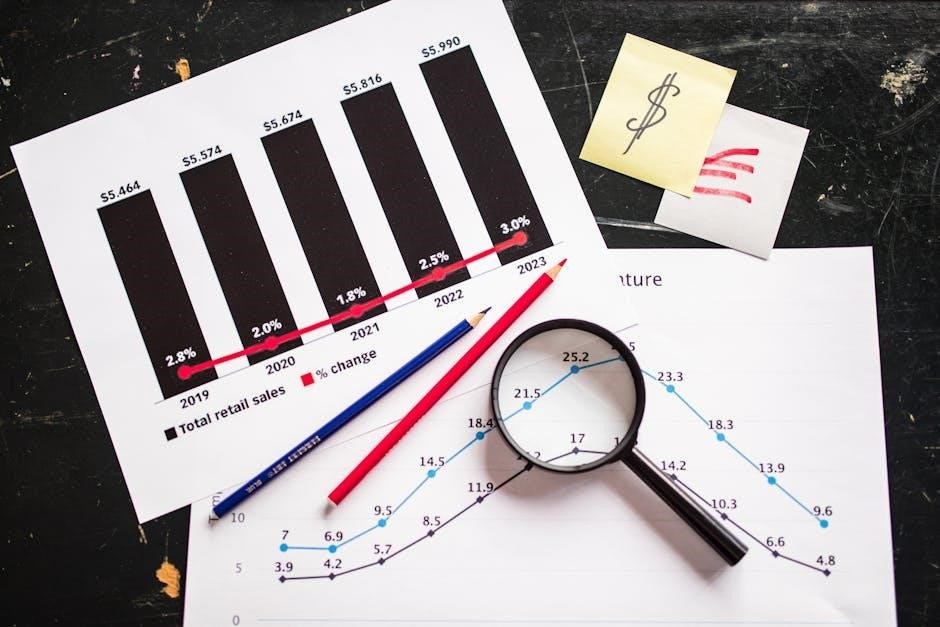A Centigrade to Fahrenheit chart is a practical tool for converting temperatures between the two scales, essential for everyday applications, scientific research, and international communication․
1․1 Overview of Temperature Conversion
Temperature conversion is the process of changing a temperature reading from one unit to another, such as from Celsius to Fahrenheit․ It is a fundamental skill in science, cooking, and engineering, enabling accurate communication across different systems․ The Celsius and Fahrenheit scales are the most commonly used, with Celsius being part of the metric system and Fahrenheit widely used in the United States․ A Centigrade to Fahrenheit chart simplifies this process by providing a visual reference for quick conversions, making it an invaluable tool for both professionals and everyday users seeking precise temperature translations․
1․2 Importance of Understanding Celsius and Fahrenheit
Understanding Celsius and Fahrenheit is crucial for global communication, as different countries use different scales․ In science and engineering, precise temperature measurements are essential, and errors can lead to significant consequences․ Everyday activities like cooking and weather forecasting also rely on accurate conversions․ A Centigrade to Fahrenheit chart helps bridge this gap, ensuring clarity and precision․ It is especially vital for professionals working in international settings, where miscommunication could lead to errors․ Mastery of these conversions enhances efficiency and accuracy in various fields, making it a foundational skill for both personal and professional use․
1․3 Purpose of a Centigrade to Fahrenheit Chart
A Centigrade to Fahrenheit chart serves as a quick reference guide for converting temperatures between the two scales․ It simplifies the process by providing pre-calculated values, eliminating the need for manual calculations․ This tool is particularly useful for individuals without a strong mathematical background or those needing rapid conversions․ The chart is widely used in education, cooking, and industrial settings where precise temperature control is necessary․ Its purpose is to enhance efficiency, reduce errors, and ensure accuracy in temperature conversions, making it an indispensable resource for both professionals and everyday users․ By offering a clear and organized format, it facilitates easy understanding and application․

The Conversion Formula
The Centigrade to Fahrenheit conversion formula is a mathematical equation that allows precise temperature conversion․ It is essential for understanding how to accurately convert Celsius to Fahrenheit․
2․1 Mathematical Formula for Celsius to Fahrenheit
The mathematical formula to convert Celsius to Fahrenheit is F = (C × 9/5) + 32․ This formula ensures accurate temperature conversion by multiplying the Celsius value by 9/5 and adding 32․ It provides a straightforward method for converting temperatures between the two scales, which is crucial for various applications such as scientific research, cooking, and engineering․ Understanding this formula is essential for using a Centigrade to Fahrenheit chart effectively, as it allows users to verify the accuracy of the chart’s data․ This formula remains the standard for temperature conversion worldwide․
2․2 Step-by-Step Explanation of the Conversion Process
To convert Celsius to Fahrenheit, follow these steps:
Identify the Celsius temperature (C) that needs to be converted․
Multiply the Celsius temperature by 9/5 (or 1․8)․
Add 32 to the result from step 2․
Record the final value, which is the temperature in Fahrenheit (F)․
For example, to convert 30°C:
- 30 × 9/5 = 54
- 54 + 32 = 86°F
This method ensures accurate and quick conversions using the formula F = (C × 9/5) + 32․
2․3 Examples of Converting Specific Temperatures
Here are examples of converting Celsius to Fahrenheit:
– 0°C (freezing point of water) = 32°F․
– 37°C (human body temperature) = 98․6°F․
– 100°C (boiling point of water) = 212°F․
– -40°C = -40°F (a unique point where both scales align)․
These examples demonstrate how common temperatures are converted using the formula F = (C × 9/5) + 32․
Such conversions are essential for everyday applications, scientific research, and understanding global weather patterns․

How to Use a Centigrade to Fahrenheit Chart
A Centigrade to Fahrenheit chart simplifies temperature conversion by allowing quick lookup of corresponding values․ Users can align Celsius values with Fahrenheit equivalents for accurate results․
3․1 Understanding the Structure of the Chart
A Centigrade to Fahrenheit chart is typically organized as a table with two columns: one for Celsius temperatures and another for their Fahrenheit equivalents․ The chart is designed in a grid format, with clear headers labeling each column for easy identification․ Celsius values are usually listed in ascending order on the left, while the corresponding Fahrenheit temperatures are displayed on the right․ The chart may include numerical intervals, such as every 5 or 10 degrees, to simplify the conversion process․ Visual cues like bold headers or alternating row colors can enhance readability․ This structured format ensures users can quickly locate and interpret temperature conversions accurately․
3․2 Locating Specific Temperatures on the Chart
To locate a specific temperature on a Centigrade to Fahrenheit chart, users can follow a straightforward process․ Start by identifying the Celsius value in the left column․ Scan down the Celsius column until the desired temperature is found․ Once located, move horizontally to the right to find the corresponding Fahrenheit value․ For temperatures not listed, interpolation between the nearest values can provide an approximate conversion․ Some charts may include an index or legend to guide users, ensuring quick and efficient navigation․ This method ensures accuracy and saves time when converting temperatures without a calculator or digital tool․
3․3 Interpreting the Data for Accurate Conversions
Interpreting a Centigrade to Fahrenheit chart requires attention to detail to ensure accurate conversions․ Users should first identify the scale increments and align the Celsius and Fahrenheit values correctly․ For precise readings, avoid guessing between marked temperatures; instead, use the chart’s intervals to estimate values․ Digital tools can enhance accuracy by providing exact conversions, reducing the risk of human error․ Always verify critical temperatures, such as freezing or boiling points, to ensure reliability․ By understanding the chart’s structure and cross-referencing with the conversion formula, users can achieve accurate and reliable results, making the chart an indispensable resource for temperature conversions․

Finding a Centigrade to Fahrenheit Chart PDF
To find a reliable Centigrade to Fahrenheit chart PDF, search educational or scientific websites, ensuring the chart is updated and accurately formatted for precise conversions․
4․1 Sources for Downloading Printable Charts
Printable Centigrade to Fahrenheit charts can be downloaded from educational websites, scientific resources, or official organizations like NASA and NOAA․ These charts are often free, easy to print, and include both Celsius and Fahrenheit scales for quick reference․ Many websites offer customizable charts, allowing users to select temperature ranges that suit their needs․ When downloading, ensure the chart is from a reputable source to guarantee accuracy․ Look for charts with clear formatting and precise conversions․ This ensures reliability for applications in cooking, education, or engineering․ Always verify the source to avoid errors in critical temperature conversions․
4․2 Features to Look for in a Reliable Chart
A reliable Centigrade to Fahrenheit chart should have clear, legible formatting with distinct Celsius and Fahrenheit scales․ It should cover a wide temperature range, from freezing to boiling points, ensuring versatility for various applications․ Look for charts with incremental markings, such as every 1°C or 5°F, to facilitate precise conversions․ Color-coded sections or shading can enhance readability․ Ensure the chart includes the mathematical formula for conversions, serving as a quick reference․ Accuracy is crucial, so verify that the chart aligns with the standard formula: Fahrenheit = (Celsius × 9/5) + 32․ Avoid charts with cluttered designs or unclear markings that may lead to confusion․
4․3 How to Verify the Accuracy of the Chart
To ensure the chart’s accuracy, cross-check it with the standard formula: Fahrenheit = (Celsius × 9/5) + 32․ Verify known temperature equivalents, such as 0°C = 32°F and 100°C = 212°F․ Use an online converter to confirm conversions for random temperatures․ Ensure the chart’s scale increments are consistent and logical․ Check for any visible errors in formatting or alignment․ If the chart includes a formula section, confirm it matches the standard conversion formula․ Accuracy is crucial for reliable use in scientific, culinary, or engineering applications․ Always verify with trusted sources before relying on the chart for critical tasks․

Practical Applications of the Conversion Chart
The chart is essential for scientific research, cooking, and engineering, ensuring accurate temperature conversions in laboratories, kitchens, and construction sites, facilitating global communication and precise measurements․
5․1 Use in Scientific Research and Experiments
In scientific research, precise temperature conversions are crucial for accurate data interpretation․ A Centigrade to Fahrenheit chart is frequently used in experiments involving thermal dynamics, material testing, and climate studies․ By providing quick reference points, it minimizes errors during data recording and analysis․ Researchers rely on this tool to ensure consistency across studies, especially when collaborating internationally where different units are used․ The chart’s simplicity makes it an indispensable resource in laboratories, enabling seamless conversions without the need for complex calculations or digital tools, thereby maintaining workflow efficiency and accuracy in critical experiments․
5․2 Applications in Cooking and Food Safety
In cooking, precise temperature control is vital for achieving desired results, making a Centigrade to Fahrenheit chart indispensable․ It aids in converting recipe temperatures, ensuring dishes like baked goods and candies turn out perfectly․ For food safety, accurate conversions are critical to prevent undercooking or overcooking, which can lead to foodborne illnesses․ For instance, ensuring meat reaches a safe internal temperature of 145°F (63°C) is crucial․ The chart simplifies these conversions, allowing chefs and home cooks to work efficiently without errors․ This tool is especially handy in kitchens where quick, accurate temperature adjustments are essential for both creativity and safety․
5․3 Importance in Engineering and Construction
In engineering and construction, accurate temperature conversions are critical for material properties, safety, and system design․ A Centigrade to Fahrenheit chart ensures precise calculations for heating, cooling, and structural integrity․ For instance, in manufacturing, temperature tolerances for materials like steel and plastics must be exact to prevent defects․ In construction, HVAC systems and concrete curing rely on accurate temperature monitoring․ The chart serves as a quick reference, preventing costly errors and ensuring compliance with international standards․ Its reliability makes it a cornerstone tool for engineers and contractors working across regions with different temperature scales, ensuring safety and efficiency in diverse projects․

Limitations and Challenges
Despite its usefulness, a Centigrade to Fahrenheit chart has limitations, including potential human error, inaccuracy at extreme temperatures, and challenges in creating a comprehensive guide․
6․1 Potential for Human Error in Reading the Chart
One major limitation of using a Centigrade to Fahrenheit chart is the potential for human error when interpreting the data․ Users may mistake one temperature for another due to misalignment of scales or hurried reading․ Additionally, inaccurate estimates can occur if the chart lacks clear markings or is poorly designed․ Small print or overcrowded data can also lead to misinterpretation; These errors highlight the importance of double-checking readings and ensuring the chart is well-designed for clarity․ Despite these challenges, proper training and attention to detail can minimize such risks;
6․2 Inaccuracy at Extreme Temperatures
Centigrade to Fahrenheit charts may exhibit inaccuracy at extreme temperatures, particularly when dealing with very high or low values․ This is often due to the non-linear nature of the conversion formula, which can become less precise at the outer ranges of the scale․ For instance, temperatures near absolute zero or extremely high heat may not align perfectly on the chart, leading to small discrepancies․ Additionally, the chart’s resolution may be insufficient for such extremes, making accurate readings difficult․ To address this, digital tools or advanced calculators are often recommended for precise conversions in these scenarios․
6․3 Challenges in Creating a Comprehensive Chart
Creating a comprehensive Centigrade to Fahrenheit chart presents several challenges․ One major issue is ensuring accuracy across a wide temperature range, as the conversion formula’s precision can vary at extreme values․ Additionally, the chart must be visually organized to avoid clutter, especially when including both common and less frequently used temperatures․ Another challenge is balancing detail and simplicity; too much data can overwhelm users, while too little may limit its usefulness․ Designing a chart that meets diverse needs, from scientific precision to everyday practicality, requires careful planning and testing․

Creating a Custom Centigrade to Fahrenheit Chart
Designing a custom chart involves creating a clear layout with precise temperature intervals․ Use tools like Excel or graphic design software for accuracy and readability, customizing the format for specific needs․
7․1 Designing the Chart for Clarity and Readability
To ensure clarity, use a clean layout with distinct rows and columns․ Implement a consistent color scheme and readable fonts․ Highlight key temperature markers for quick reference․ Include clear labels for both Celsius and Fahrenheit scales․ Use gridlines to separate values, enhancing readability․ Ensure adequate spacing to avoid overcrowding․ Consider adding a legend or footer for conversion formula references․ Use bold headings for temperature ranges to guide users effectively․ Optimize the chart for both print and digital formats, ensuring scalability․ These design elements will make the chart user-friendly and accessible for diverse applications․ By prioritizing clarity, the chart becomes an indispensable tool for accurate temperature conversions․
7․2 Tools and Software for Generating the Chart
Popular tools for creating a Centigrade to Fahrenheit chart include spreadsheet software like Excel or Google Sheets, where formulas can automate conversions․ Design tools like Canva or Adobe Illustrator offer visually appealing templates․ For developers, programming languages such as Python or JavaScript can generate dynamic charts․ Online chart generators also provide quick solutions․ Ensure the tool supports precise temperature calculations and customizable formatting․ Many tools allow exporting charts as PDFs, making them easy to share and print․ Choosing the right software depends on your technical skill level and design requirements, ensuring the chart is both accurate and visually appealing․
7․3 Saving and Sharing the Chart in PDF Format
To save your Centigrade to Fahrenheit chart as a PDF, use the “Save As” or “Export” feature in your design or spreadsheet software․ Ensure the layout and margins are correctly set for printing․ Many tools automatically optimize the PDF for clarity․ Once saved, share the PDF via email, cloud storage, or direct download links․ You can also embed it in documents or websites․ This format maintains the chart’s professional appearance and ensures compatibility across devices․ Regularly update the chart if temperature ranges or designs change to keep it relevant and useful for all users․ PDFs are ideal for widespread distribution and accessibility․

Examples and Case Studies
This section showcases real-world applications of the Centigrade to Fahrenheit chart, highlighting its role in scientific research, cooking, and industrial engineering, proving its versatility and practicality․
8․1 Real-World Scenarios Where the Chart is Essential
The Centigrade to Fahrenheit chart is indispensable in various real-world scenarios, such as scientific experiments, where precise temperature conversions are critical․ In cooking, it helps chefs adjust recipes for international audiences․ Engineers rely on it for construction and manufacturing, ensuring materials meet global standards․ Additionally, it is vital for weather forecasting, allowing audiences to understand temperature reports in both scales․ This chart bridges communication gaps, facilitating accurate data interpretation across diverse fields and regions․ Its simplicity and accessibility make it a cornerstone tool for anyone needing reliable temperature conversions․
8․2 Historical Development of Temperature Conversion Charts
The development of temperature conversion charts dates back to the 18th century, when Fahrenheit and Celsius scales were first introduced․ Early charts were handcrafted for scientific and practical use, aiding in the standardization of temperature measurement․ By the 19th century, printed charts became widespread, particularly in scientific and engineering fields․ The 20th century saw the rise of digital tools, reducing reliance on physical charts․ Today, PDF versions of these charts are popular for their portability and ease of use, continuing a legacy of precise temperature conversion that bridges global communication gaps․ This evolution reflects the enduring need for accurate temperature data․
8․3 Success Stories of Using the Chart in Various Fields
The Centigrade to Fahrenheit chart has proven indispensable across industries․ In cooking, chefs use it to ensure precise temperature control for food safety and recipe consistency․ Engineers rely on it for material performance analysis under varying conditions․ Meteorologists utilize it to communicate weather forecasts accurately to global audiences․ One notable success story involves a pharmaceutical company that employed the chart to maintain vaccine storage integrity during international transport․ Such examples highlight the chart’s versatility and critical role in bridging communication gaps, ensuring accuracy, and enabling efficient operations worldwide․ Its widespread adoption underscores its enduring value in diverse professional settings․

The Future of Temperature Conversion Tools
The future of temperature conversion tools lies in AI-driven digital solutions, integrating seamlessly with smart devices for real-time, accurate conversions, enhancing efficiency across industries globally․
9․1 Advancements in Digital Conversion Tools
Digital conversion tools are evolving rapidly, offering enhanced accuracy and user-friendly interfaces․ With AI integration, these tools can now handle complex conversions in real-time, reducing human error․ Mobile apps and web-based platforms provide instant access to temperature conversion, making them indispensable in various fields․ Additionally, voice-activated tools and augmented reality features are being developed, allowing for hands-free and immersive conversion experiences․ These advancements ensure that users across industries, from cooking to engineering, can rely on precise and efficient temperature conversions․ The future promises even more innovative solutions to meet growing demands․
9․2 Integration with Smart Devices and Apps
The integration of temperature conversion tools with smart devices and apps has revolutionized accessibility and convenience․ Users can now instantly convert Celsius to Fahrenheit using voice commands on smart assistants like Siri or Alexa․ Mobile apps offer offline functionality, ensuring conversions are possible without internet connectivity․ Wearable devices and smart home systems also incorporate these tools, providing seamless integration into daily routines․ This integration enhances productivity for professionals and simplifies tasks for everyday users, making temperature conversion more efficient and widely accessible than ever before․ The future of smart devices promises even deeper integration and functionality․
9․3 The Role of AI in Enhancing Conversion Accuracy
AI plays a pivotal role in enhancing the accuracy of temperature conversions․ By leveraging machine learning algorithms, AI can analyze patterns and detect anomalies in conversion data, ensuring precise results․ AI-powered tools adapt to user behavior, learning preferences and frequently used temperature ranges to optimize performance․ Additionally, AI-driven systems can automatically update conversion charts and formulas, incorporating new scientific standards․ This capability minimizes human error and ensures consistency across various devices and platforms․ As AI technology advances, its role in maintaining high accuracy for temperature conversion tools will continue to expand, providing reliable solutions for users worldwide․

Common Mistakes to Avoid
Common mistakes include misreading the chart due to poor design or small fonts, forgetting to apply the conversion formula correctly, and relying solely on the chart without understanding the formula․
10․1 Misreading the Chart Due to Poor Design
Poorly designed charts can lead to misreading, especially if the font is too small or the layout is cluttered․ Ensure the chart uses clear, legible fonts and a logical structure to prevent confusion․ Proper spacing between temperature values and distinct color coding can enhance readability․ Avoid charts with overlapping data or unclear axes, as they increase the likelihood of errors․ Always verify the chart’s accuracy by cross-referencing with known temperature conversions, such as 0°C to 32°F or 100°C to 212°F, to ensure reliability․ A well-designed chart minimizes mistakes and improves efficiency in temperature conversion tasks․
10․2 Forgetting to Apply the Conversion Formula Correctly
Forgetting to apply the Celsius to Fahrenheit formula correctly is a common mistake, especially when relying solely on a chart․ The formula, °F = (°C × 9/5) + 32, must be applied accurately to ensure precise conversions․ Misapplying the formula, such as reversing the multiplication or addition steps, can lead to significant errors․ For example, converting 20°C might result in 68°F if done correctly, but errors like adding before multiplying could yield incorrect results․ Always double-check the formula application, especially for critical measurements in cooking or scientific experiments․ Using known temperature equivalents, like 0°C to 32°F, can help verify accuracy․
10․3 Relying Solely on the Chart Without Understanding the Formula
Relying solely on a Centigrade to Fahrenheit chart without understanding the conversion formula can lead to errors, especially in situations where the chart is unavailable․ While charts are convenient, they may not cover all temperatures or scenarios․ Without knowing the formula, users cannot verify conversions or adapt to unique cases․ For example, if a chart skips intervals, precise conversions may be compromised․ Understanding the formula (°F = (°C × 9/5) + 32) ensures accuracy and independence from charts․ This knowledge is crucial for critical applications like cooking, engineering, or scientific research, where temperature precision is vital․ Always cross-verify with the formula when possible․
A Centigrade to Fahrenheit chart is an essential tool for accurate temperature conversions, aiding in scientific research, cooking, and engineering․ Always combine it with formula understanding for reliability․
11․1 Summary of Key Points
This guide emphasizes the importance of understanding and using Centigrade to Fahrenheit charts for accurate temperature conversions․ It highlights the formula ( F = (C imes rac{9}{5}) + 32 ) and the practical applications of the chart in cooking, science, and engineering․ The availability of printable PDF charts and the need for careful design to avoid errors are also key points․ The guide encourages users to balance reliance on charts with a solid understanding of the conversion formula for optimal accuracy․ By following these principles, individuals can effectively navigate temperature conversions in various fields․
11․2 Final Thoughts on the Importance of the Chart
The Centigrade to Fahrenheit chart remains an indispensable resource for individuals needing precise temperature conversions․ Its simplicity and accessibility make it a vital tool across various industries, from cooking to engineering․ By providing a clear, visual reference, the chart bridges the gap between the two scales, ensuring accuracy and efficiency․ As technology advances, the chart continues to serve as a reliable backup for digital tools, emphasizing the enduring value of traditional methods․ Its universal applicability underscores its importance in maintaining consistency and clarity in a globalized world, where understanding temperature is crucial for communication and collaboration․
11․3 Encouragement to Use and Share the Chart
A Centigrade to Fahrenheit chart is an invaluable tool for anyone needing to convert temperatures quickly and accurately․ Its user-friendly design makes it accessible to individuals of all skill levels, ensuring reliable results․ Whether for academic, professional, or personal use, this chart simplifies temperature conversion, saving time and reducing errors․ Sharing the chart with others, either digitally or in print, can enhance productivity and facilitate clear communication․ Encourage others to adopt this practical resource, as it serves as a timeless aid in understanding and working with temperature scales․ Make it a go-to tool in your daily activities!
